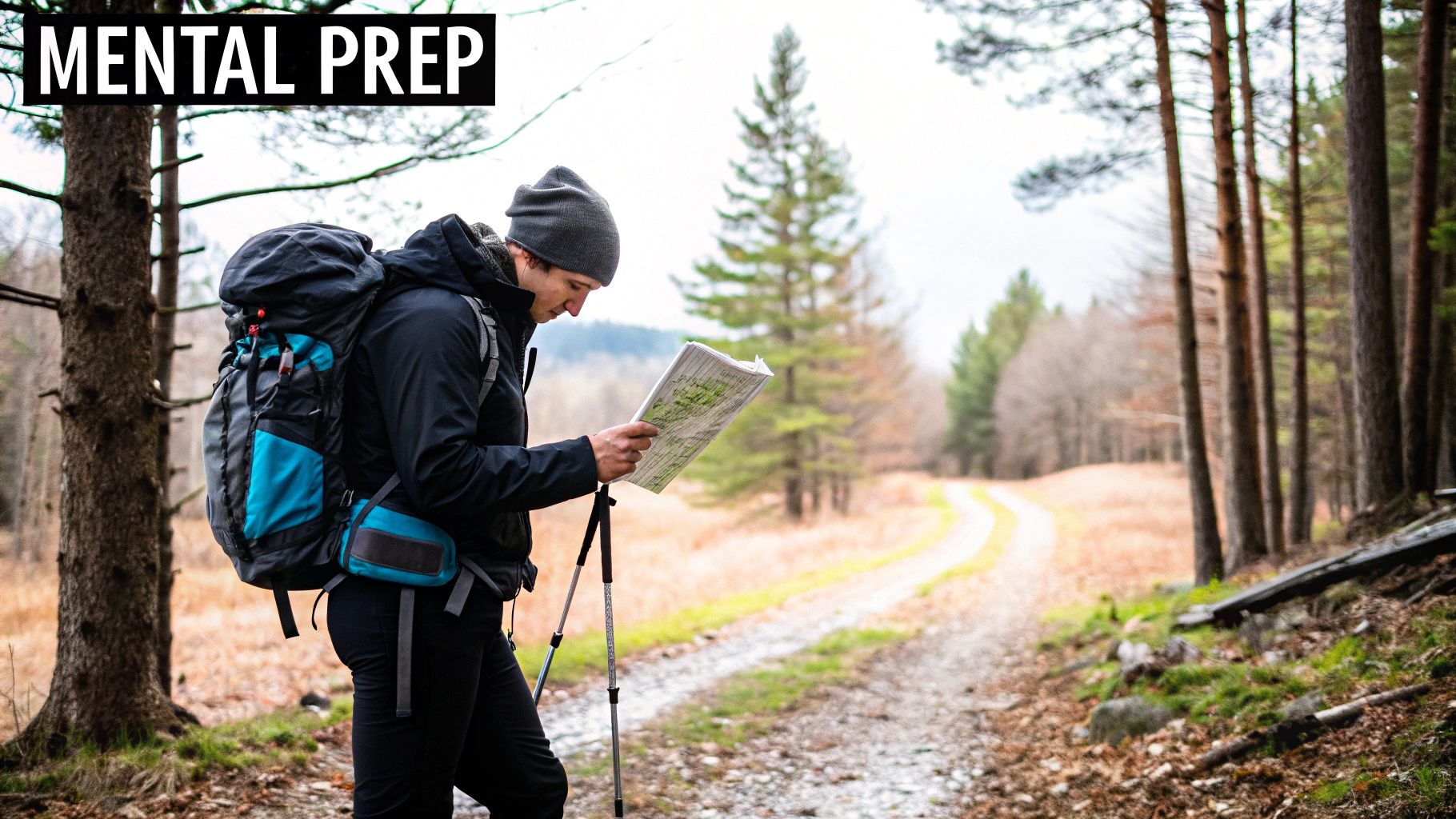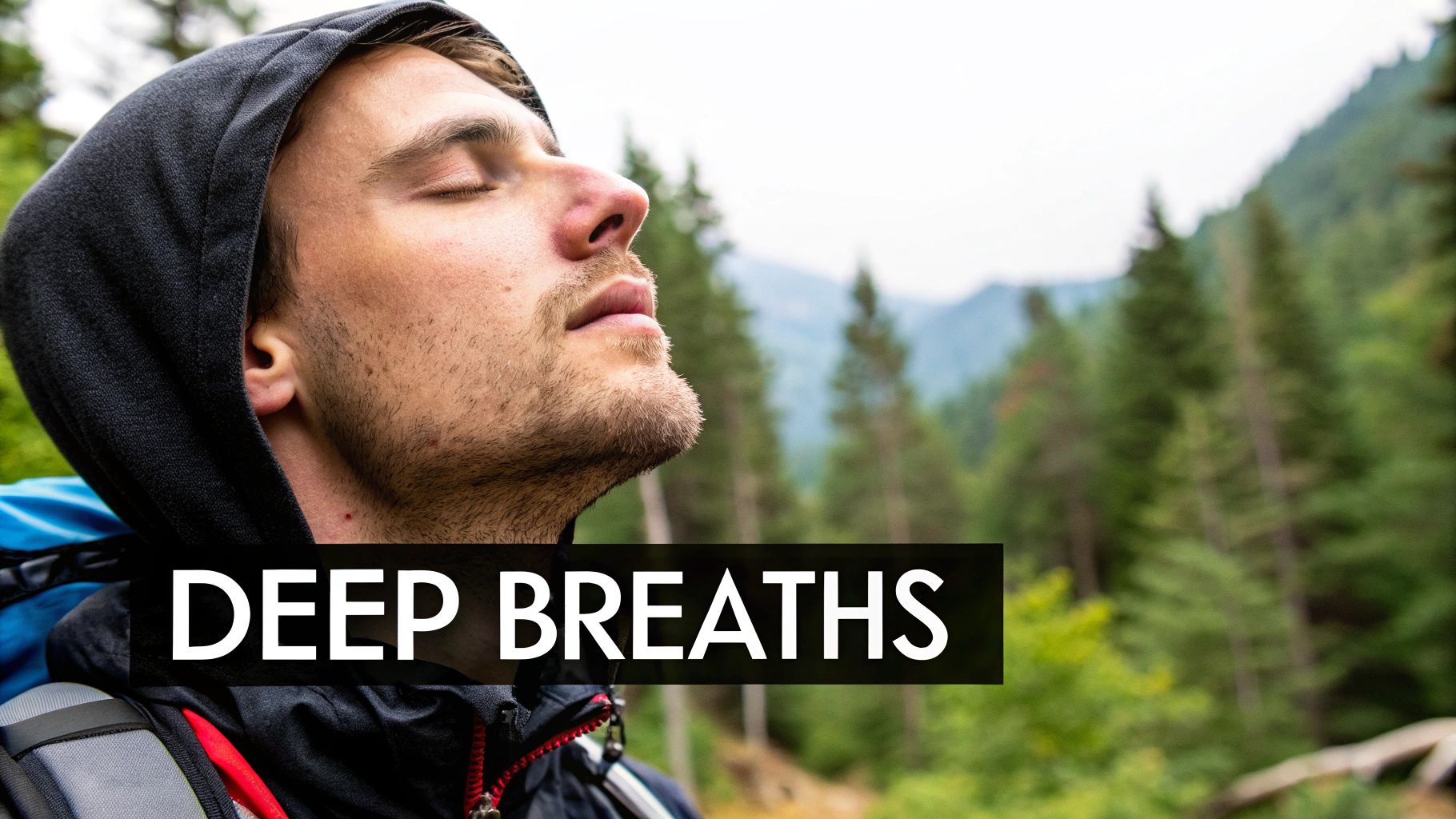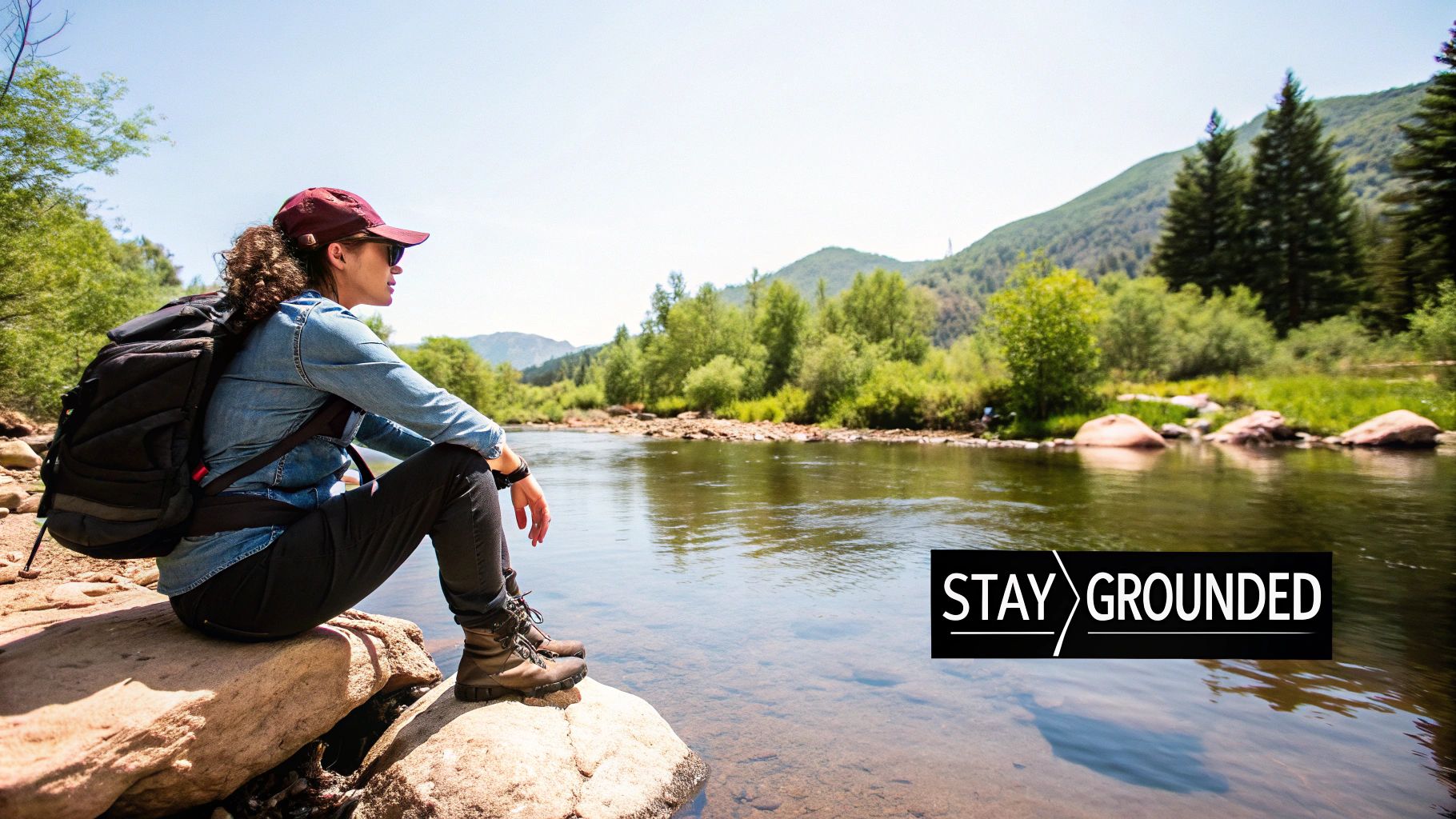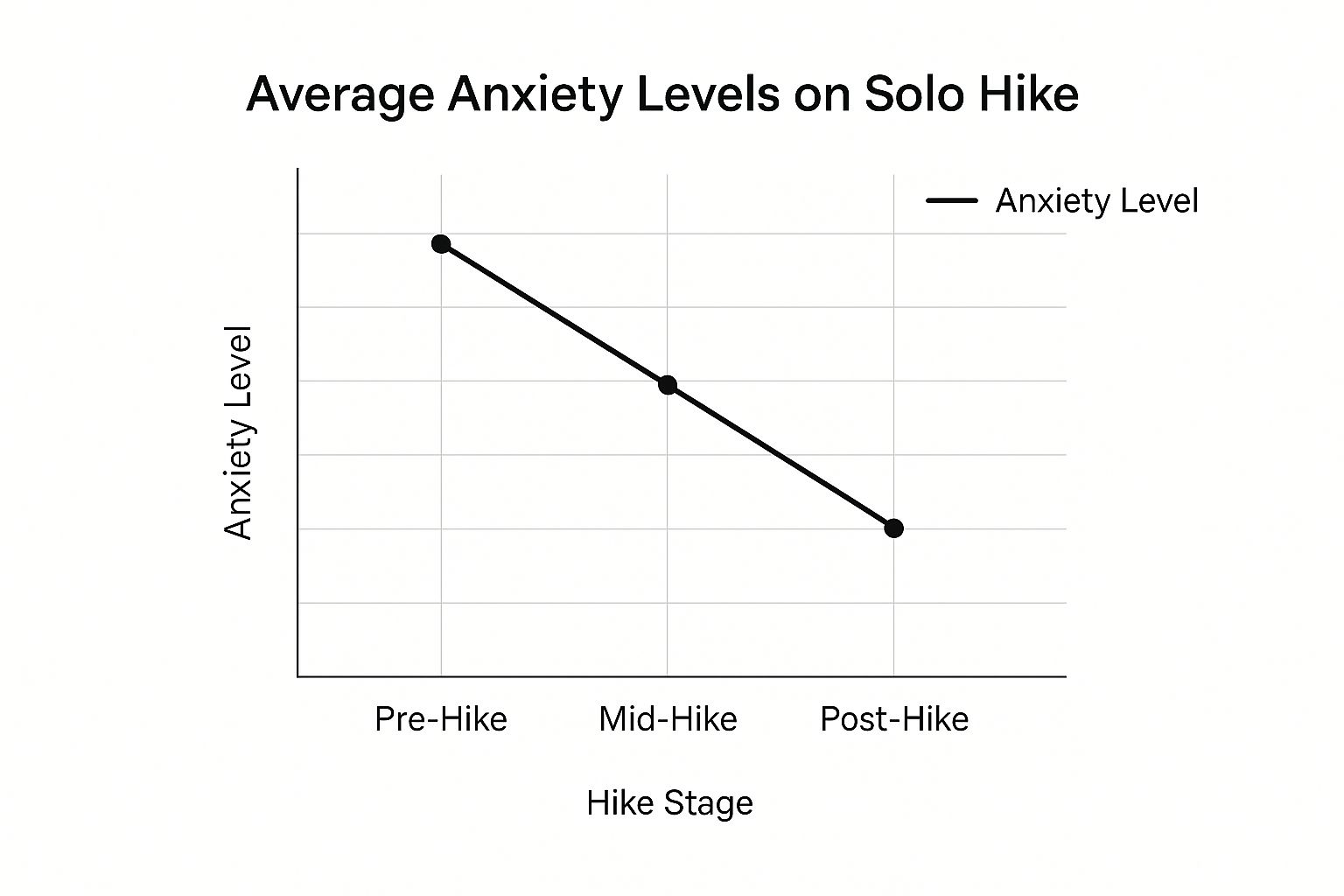With over 10,000 orders
With over 10,000 orders

Tackling solitude anxiety on a solo hike is all about shifting your mindset. It's a journey from fear to empowerment, built on preparation, on-trail coping methods, and mindful reflection. This guide is your roadmap, designed to turn that feeling of apprehension into a powerful sense of self-reliance and a deeper connection with nature.
The thought of hiking completely alone can bring on a weird mix of excitement and a deep, churning unease. If picturing yourself on a quiet trail makes your stomach do flips, you're not alone. That feeling is just a natural, protective response kicking in when we face something new or unfamiliar.

But here's the thing: pushing through that initial discomfort unlocks some incredible rewards. Solo hiking builds a profound sense of self-reliance, forces you to sharpen your decision-making skills, and lets you connect with the natural world without any interruptions. It's your chance to move at your own pace, listen to your own thoughts, and tap into a strength you might not even know you have.
Let's be real, the fears that pop up are pretty common and often very specific. We worry about things like twisting an ankle, getting turned around, or running into wildlife (or even other people). The first step is just to name these fears. Once you know what they are, you can hit them with practical, real-world strategies, like carrying a personal locator beacon (PLB) or leaving a detailed itinerary with someone you trust.
To really get a handle on your solitude anxiety, it helps to understand what it is. For many of us, this feeling is a form of situational anxiety, where a specific environment, like a quiet trail, is the trigger for those intense feelings.
Facing these feelings isn’t about making fear disappear entirely. It's about learning to hike alongside it. Each step you take alone builds a foundation of confidence that will stick with you long after you've left the trail.
This guide is designed to give you that foundation. We'll walk through everything you need to know, breaking it down into simple, actionable pieces.
Before we dive deep, here’s a quick-reference table matching some of the most common solo hiking fears with some foundational strategies to get you started.
This table is a great starting point to see how a little preparation can directly address the "what ifs" that might be holding you back.
| Common Fear | Initial Strategy to Manage It |
|---|---|
| Getting Lost | Master basic navigation with a map and compass; always carry a GPS device or phone app as a reliable backup. |
| Injury or Emergency | Carry a well-stocked first-aid kit and a communication device that works offline, like a PLB or satellite messenger. |
| Encountering Wildlife | Research the animals in the area and learn proper encounter protocols, like making noise on the trail to avoid surprises. |
| Loneliness or Panic | Practice simple mindfulness techniques at home and have a "positive distraction" ready, like a favorite podcast or audiobook. |
Think of these as the first tools in your mental toolkit. As we go, we’ll build on each one, giving you the confidence to not just manage your anxiety, but to truly thrive in solitude.
Let's be honest: managing the anxiety that can crop up on a solo hike starts long before your boots ever touch the trail. It's all about building a solid mental foundation, shifting your mindset from apprehension to genuine anticipation. The idea is to create a mental toolkit ahead of time, so when you step into the quiet of the woods, you feel prepared, not panicked.

This whole process begins with small, deliberate steps. Don't picture some multi-day epic for your first solo trip. Instead, think local and familiar. Pick a trail you know like the back of your hand, or at least one that's popular and well-trafficked.
Easing into solitude this way dramatically lowers the stakes. It helps you get comfortable with your own company in an environment that feels safe and controlled. For more great ideas on how to get started, check out this excellent beginner's guide to hiking solo.
There's a reason top athletes and adventurers swear by visualization—it flat-out works. Before your hike, find a few quiet moments to mentally walk through the entire experience from start to finish.
Picture yourself packing your bag with total confidence. Feel the excitement as you drive to the trailhead. Imagine taking those first few steps onto the path.
Envision yourself navigating a tricky section with skill, stopping for a water break while soaking in the view, and hearing that satisfying crunch of leaves under your boots. By mentally rehearsing both the good stuff and the potential challenges, you’re training your brain to see everything as manageable. This isn’t just daydreaming; it’s strategic prep work that primes you for success and cuts down on the kind of surprises that can trigger anxiety.
Anxious thoughts love to spiral. The good news is, you can stop them in their tracks with a bit of positive self-talk. A personal mantra is just a short, powerful phrase you can repeat to yourself when doubt starts creeping in. Think of it as a mental reset button, shifting your focus from fear back to your own strength.
Your mantra needs to feel personal and true to you. Here are a few examples to get your own ideas flowing:
The wilderness solo experience, while initially daunting, is a unique opportunity for introspection. Studies on wilderness programs show that despite initial discomfort, the solo portion is often reported as the most impactful part of the journey, leading to significant personal growth and empowerment.
By weaving these mindset-building techniques into your pre-hike routine, you completely reframe the experience. Your hike is no longer a battle against fear. Instead, it becomes a journey of self-reliance—a chance to prove to yourself just how capable you really are. This mental work you do beforehand is the most important piece of gear you'll carry.
No matter how well you prepare, there will be moments on the trail when a wave of anxiety just washes over you. It happens. A strange sound in the woods, a wrong turn, or the sudden realization of just how far you are from the nearest road can send your heart racing.
When this happens, you don't need complicated psychological exercises. You need simple, effective tools that work right now.

The key isn't to fight the feeling—that rarely works. Instead, you want to gently guide your mind back to the present. These are practical, field-tested methods to help you regain your footing, both literally and figuratively.
When anxiety hits, your mind loves to jump to worst-case scenarios. Grounding techniques are designed to pull you out of that mental spiral by forcing your attention back to the physical world around you.
One of the best methods out there is the 5-4-3-2-1 technique. It’s incredibly easy to remember and works anywhere, anytime.
Just stop what you're doing, take a slow breath, and start identifying:
This simple sensory checklist forces your brain to focus on the immediate, tangible environment, effectively interrupting the cycle of anxious thoughts. Think of it as a powerful reset button that reminds you that right here, right now, you are safe.
Your breath is a direct line to your nervous system. When you feel anxious, your breathing naturally becomes shallow and rapid, telling your body you're in danger. By intentionally slowing it down, you send a powerful signal back to your brain that everything is okay.
A simple and incredibly effective method is box breathing.
Just a minute or two of this rhythmic cycle can work wonders. It helps lower your heart rate and brings a sense of calm, allowing you to think more clearly and get a handle on the situation.
Remember, the goal of these on-trail techniques is not to eliminate every flicker of fear. It's about having a reliable toolkit to manage those feelings when they arise, so you can continue your hike with confidence and enjoy the peace you set out to find.
Sometimes, the best way to deal with a racing mind is to simply give it something else to do. Having a few planned, positive distractions in your back pocket can be a game-changer.
This could be listening to a short, engaging podcast or a few songs from an uplifting playlist. You could even use an app to identify a cool plant or bird you just saw. Exploring some of the best hiking apps can give you tools that are not only useful for navigation but also serve as a great mental break.
Even taking a five-minute break to jot down a few thoughts in a small journal can provide a healthy outlet and shift your focus.
Confidence on the trail really comes down to solid preparation. One of the best ways I’ve found to quiet that nagging voice of anxiety is knowing I have the right gear and a bulletproof safety plan. This isn’t about hauling a massive pack; it’s about smart, strategic choices that empower you and create a safety net.
When you know you can navigate without a cell signal, patch up a minor injury, or call for help no matter where you are, it frees up so much mental energy. You can actually relax and enjoy the hike instead of running through worst-case scenarios. That kind of peace of mind is priceless.
This chart really nails the typical anxiety curve for solo hikers. It shows how those pre-hike jitters are often the worst part.

See? The anxiety is almost always at its peak before you even hit the trail. Once you're moving and engaged with your surroundings, it drops off a cliff.
While your full packing list will change with the seasons and the trail, a few items are absolutely essential for solo safety. I think of these as my core confidence-builders.
Satellite Messenger or PLB: This is your connection to the outside world when cell service is a distant memory. A satellite messenger like a Garmin inReach offers two-way texting (great for checking in), location tracking, and an SOS button. A Personal Locator Beacon (PLB) is a simpler, one-way device that just sends an SOS signal. The messenger is more versatile, but the PLB is a straightforward emergency lifeline.
Navigation Tools: Your phone is a great tool, but never your only tool. A physical map and a compass are your most reliable backups because they don't have batteries that can die. The key is to practice with them on trails you already know. That way, using them becomes second nature when you actually need them.
First-Aid Kit: Carry a well-stocked kit, and more importantly, know how to use everything inside it. At a minimum, you should have blister care, various bandages, antiseptic wipes, pain relievers, and any personal meds. As many comprehensive hiking safety tips for beginners point out, personalizing your kit for your own needs is crucial.
Choosing between a PLB and a satellite messenger can feel tricky. Here's a quick comparison to help you decide what's right for your style of hiking.
| Feature | Personal Locator Beacon (PLB) | Satellite Messenger |
|---|---|---|
| Primary Function | One-way SOS distress signal | Two-way messaging, tracking, SOS |
| Communication | Sends your location to rescue services | Text messages, emails, social media updates |
| Subscription Cost | None (Registration required) | Monthly or annual subscription plan |
| Initial Cost | $250 - $400 | $300 - $500 |
| Best For | "Just in case" emergency use; budget-conscious | Staying connected, peace of mind for family |
| Example | ACR ResQLink | Garmin inReach Mini 2, ZOLEO |
Ultimately, the choice depends on your budget and how much you want to communicate from the backcountry. Either one is a massive step up in safety.
Leaving a detailed plan with someone you trust is one of the most critical safety steps you can take. This is more than a quick text saying, "Heading to the mountains!" A proper itinerary is the first tool rescuers will use if you don't come back on time.
Your itinerary is your lifeline back to the front-country. It should be clear and detailed enough that someone who knows nothing about hiking can give it to authorities and provide them with a strong starting point.
Make sure your plan includes:
Taking 15 minutes to do this before you leave provides an incredible sense of security. You know that if something goes wrong, a plan is in place to get you help.
The real journey doesn't end when you unlace your boots. Far from it. What you do after the hike is how you turn a challenging day on the trail into a lifelong source of resilience. This is where you consciously reframe the story you tell yourself.
Instead of thinking, "Wow, I survived being scared," you learn to see it as, "I faced that fear and came out stronger." Every successful solo trip, no matter how short or easy, becomes another brick in the foundation of your confidence—a confidence that you'll carry with you long after you've left the trailhead behind.
One of the best ways I’ve found to lock in those hard-won lessons is through journaling. It sounds simple, but spending just 15-20 minutes after a hike to write down your thoughts can make all the difference. It transforms a fleeting memory into a concrete lesson in your own capability.
Not sure where to start? Try these prompts:
This isn't just about recapping the hike; it's about actively weaving those experiences into how you see yourself.
"The benefits of hiking in nature, especially in solitude, are well-documented. A Stanford-led study found that walking in natural areas can significantly reduce symptoms of depression by decreasing activity in a brain region associated with rumination. Discover more about these mental health findings and see how nature directly impacts your brain."
A huge, often overlooked, part of solo hiking is the built-in digital detox. When you're out there alone, you're naturally unplugging, and this quiet space is where real self-reflection happens.
Learning about the benefits of a digital detox can help you appreciate this time even more. It’s a chance for your mind to reset without the constant buzz of notifications and endless scrolling, which powerfully enhances the positive impact of your time alone.
Ultimately, managing anxiety on a solo hike isn't about getting rid of fear entirely. Fear is a normal, healthy part of pushing your boundaries. It's about learning to walk alongside it, armed with the right tools, preparation, and the hard-earned knowledge that you are far more capable than you think. Each hike becomes proof of your own strength, transforming solitude from something to be feared into a source of profound personal empowerment.
Even after you've done all your homework and packed your bag, it's those pesky "what if" scenarios that can really start to echo in your head once you're out there. The best way to quiet them down is to face them head-on.
So, let's walk through some of the biggest concerns that pop up for solo hikers. Having a solid, practical plan for each one is the final piece of the confidence puzzle.
This is a huge one for a lot of people, but the good news is that most wildlife encounters are totally peaceful and over in a flash. It all comes down to being calm and prepared. Before you even leave the house, do a quick search on the animals native to the area. Are we talking bears, moose, rattlesnakes? Knowing what's out there is half the battle.
Your best defense on the trail is simply making a bit of noise. You don't have to yell, but talking to yourself, humming a tune, or even clapping your hands every so often is usually enough to alert animals that you're coming through. They want to avoid you just as much as you want to avoid them.
If you do come face-to-face with an animal:
Remember, you're a guest in their home. Acting in a way that is respectful and predictable is the key to turning a potentially scary moment into an awe-inspiring one.
There's feeling a little lonely, and then there's that heart-pounding, all-consuming wave of panic that can hit you out of nowhere. When that feeling washes over you, the very first thing to do is stop moving. Don't try to power through it. Find a safe spot to sit, take a sip of water, and just ground yourself.
This is the perfect moment to pull out one of the mental tools we talked about earlier, like the box breathing technique or the 5-4-3-2-1 grounding method. These aren't just fluff; they are incredibly powerful ways to calm your nervous system and bring your mind back from the brink.
It also helps to have a little "comfort item" ready to go. Maybe it's a favorite podcast downloaded to your phone, a go-to playlist that always chills you out, or just a couple of photos of your family or pets. A five-minute distraction with something familiar and positive is often all it takes to break the cycle of panic. The feeling will pass. You have what it takes to wait it out.
This is where all that planning you did beforehand really pays off. The fear of getting lost shrinks dramatically when you know you have the right gear and a solid backup plan. First off, never rely solely on your phone. Always have a physical map of the area and a compass in your pack—and take ten minutes to learn the basics of how to use them together.
Second, before you lock your front door, make sure someone knows your exact plan. Tell them your route, where you parked, and when you expect to be back. Crucially, give them a "panic" time—a specific time when they should call for help if you're not in touch.
And for the ultimate peace of mind, especially on more remote trails, look into a satellite messenger or a Personal Locator Beacon (PLB). These gadgets are your lifeline when you're off the grid. They can send pre-set "I'm okay" messages or, in a true emergency, an SOS signal with your location to search and rescue. Just knowing that button is in your pack completely changes your mental game.
At TREKOLOGY, we design the lightweight, reliable gear that gives you the confidence to explore on your own terms. From trekking poles that provide stability on tricky terrain to comfortable sleep systems for overnight adventures, our equipment is engineered to support your journey into self-reliance. Explore our full collection at https://trekology.com and gear up for your next solo adventure.
{"one"=>"Select 2 or 3 items to compare", "other"=>"{{ count }} of 3 items selected"}
Leave a comment